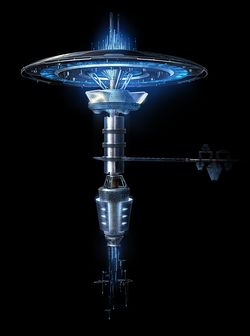Medical Starbase 253
| Medical Starbase 253 | |
|---|---|
 
| |
Medical Starbase 253 is a large Starfleet Medical facility renowned for its specialized care units and advanced training programs. Among its staff are some of Starfleet's most seasoned medical officers as well as a number of prominent civilian physicians.
Notable Programs
The Surgical Critical Care Fellowship at MS253 is one of the most prestigious training programs in not just Starfleet Medical but also the Federation itself. Many of Starfleet's most honored physicians went through the program, and any officer who completes it is pretty much assured his or her pick of assignment afterward. Though selection for the program was highly-competitive, the fellowship still had a significant attrition rate due to its rigorous nature.
Notable Staff and Alumni
- Grishols Mol, former Chief of Surgery and director of the surgical critical care fellowship
- Charles Sampi, a surgical critical care fellow and former chief medical officer of the USS Tiger-A
- Faryul Nishal, a nurse who participated in an advanced clinical fellowship from 2385-2386
- Victor Frankenstein, a Medusan researcher who studied several fields from 2382-2391.
Notable Patients
- Alleran Tan, 2388
- Tan's heart suffered severe damage when his mirror universe duplicate shot him aboard the USS Independence-A. In Trill physiology, cardiac damage may result in a neurological issue that leads to muscle wasting and possible necrosis. This issue does not respond well to treatment, although high doses of dexameraphine have shown a statistically significant reduction in the effects. Tan's recovery was slow and prolonged. He also had a vertebrae removed.
- Sven Rebane, former chief of security of the USS Pioneer, 2388
- Roshanara Rahman, 2383
- Rahman was seriously injured in 2383 from a major accident that occurred in engineering aboard the USS Tempest. She required lengthy rehabilitation at MS253, and her Kriosian physiology was not as responsive to standard dermal regeneration treatment, leaving a set of scars on the left side of her face that run across her cheekbone. Her left arm was so badly damaged from exposure to plasma coolant that the medical team initially feared they would need to replace it with a prosthetic. They were ultimately able to salvage the limb and restore function through the use of myoelectric implants to supplement destroyed nerve and muscle tissue. Her fourth and fifth fingers on her left hand were amputated and replaced with mechanical substitutes. With the loss of muscle mass, her left upper limb is noticeably thinner than her right, appearing as if there is minimal flesh over the bones with extensive scarring remaining all along her left hand, arm, and shoulder.